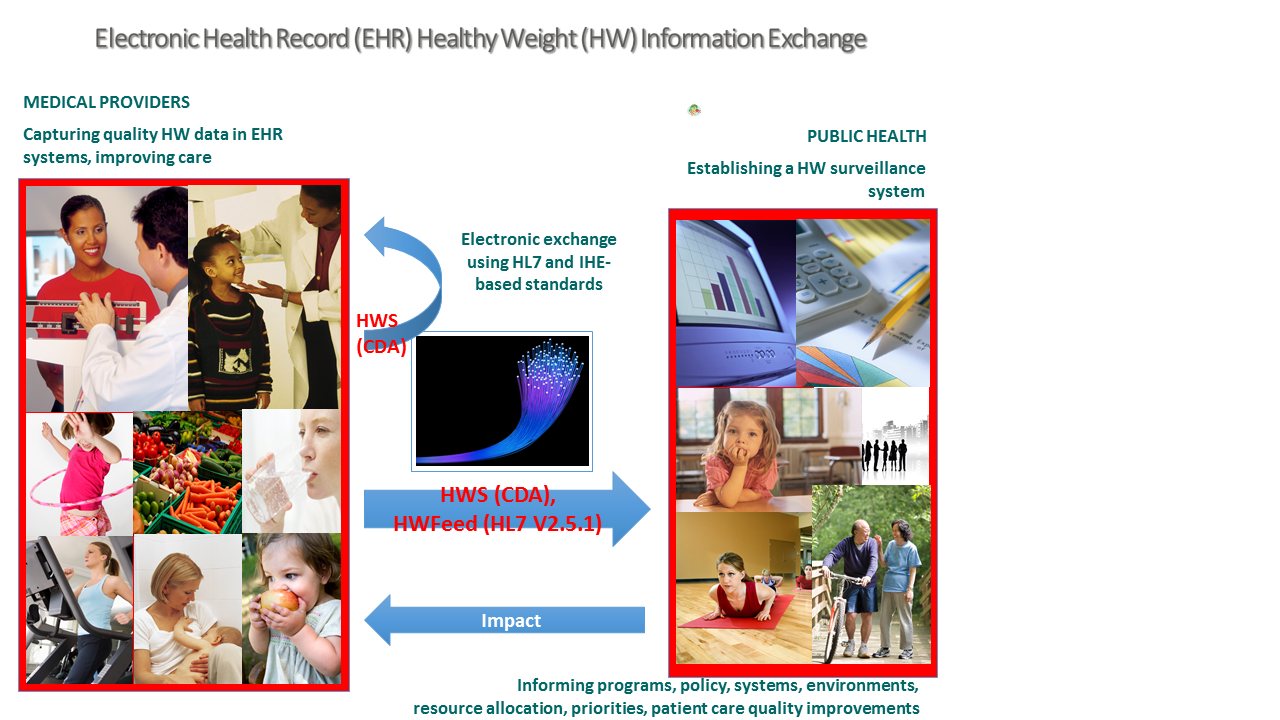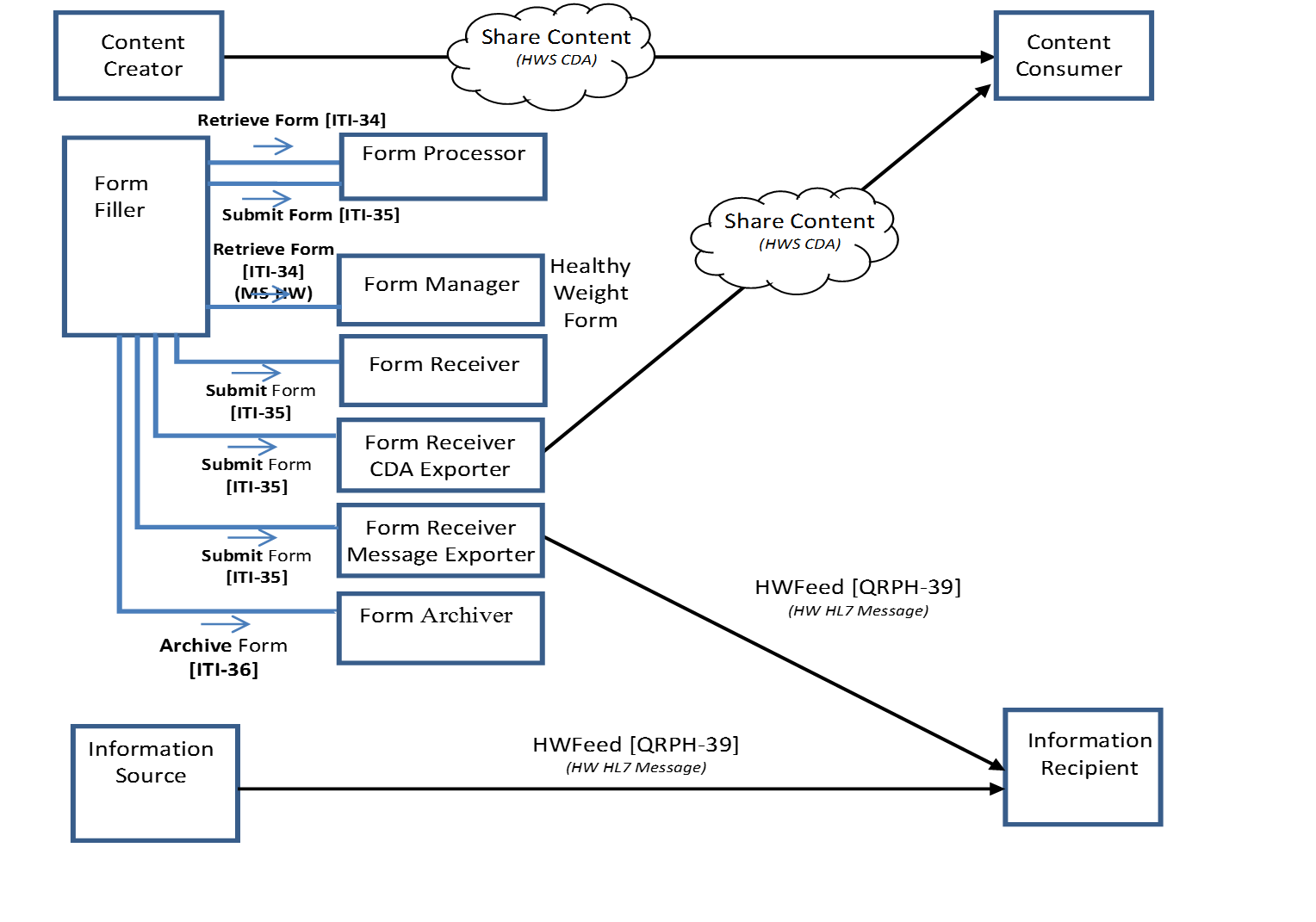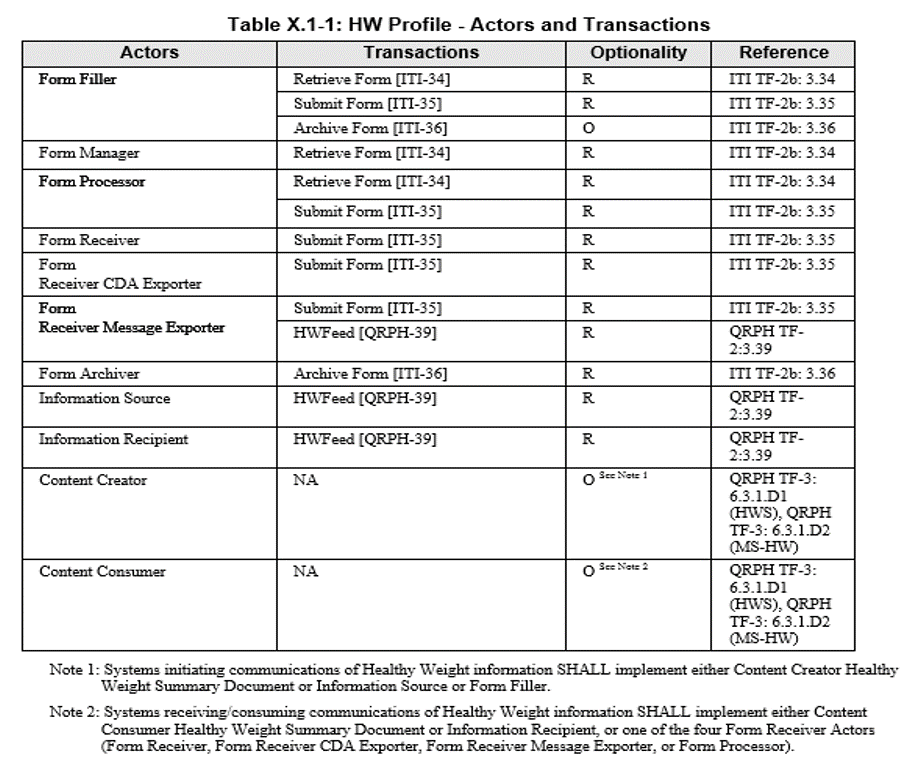Difference between revisions of "Healthy Weight"
JohnMoehrke (talk | contribs) |
|||
| (17 intermediate revisions by 2 users not shown) | |||
| Line 4: | Line 4: | ||
==Summary== | ==Summary== | ||
| − | + | 'Measured height and weight data are captured in Electronic Health Records (EHR) and are a valuable resource for public health surveillance and quality improvement activities. Fully integrated healthy weight standards in public health agency information systems have the potential to provide high quality body mass index (BMI) data that can be used by the public health community for healthy weight surveillance activities that track changes in BMI prevalence and for developing data driven program interventions this data can be used to quantitatively evaluate the impact of child obesity prevention interventions.'' | |
This IHE profile supports alignment between the EHR and public health initiatives and approaches by specifying the content and transactions to be used to capture BMI data from the EHR and communicate the BMI data to Public Health and among EHR systems for care management.'' | This IHE profile supports alignment between the EHR and public health initiatives and approaches by specifying the content and transactions to be used to capture BMI data from the EHR and communicate the BMI data to Public Health and among EHR systems for care management.'' | ||
| − | |||
| − | |||
==Benefits== | ==Benefits== | ||
| − | ' | + | 'Healthy Weight: Height/Weight measures, Counseling, Care Plan and Coordination, and Clinical Surveillance |
| + | :* Assists with the overweight and obesity identification, intervention, care management and clinical surveillance | ||
| + | :* Identifies standards and data requirements for healthy weight monitoring and intervention | ||
| + | :* Supports healthy weight goals , resources , and care plan for healthy weight improvements available to all authorized providers of care | ||
| + | :* uses several different mechanisms for capturing and communicating that information | ||
| + | :* Enables public health and population health surveillance to assure access to appropriate resources for healthy weight management | ||
| + | :* Enables communication of detailed Occupational Health information | ||
| + | '' | ||
==Details== | ==Details== | ||
| − | ' | + | 'Measured height and weight data are captured in Electronic Health Records (EHR) and are a valuable resource for public health surveillance and quality improvement activities. Fully integrated healthy weight standards in public health agency information systems have the potential to provide high quality body mass index (BMI) data that can be used by the public health community for healthy weight surveillance activities that track changes in BMI prevalence and for developing data driven program interventions this data can be used to quantitatively evaluate the impact of child obesity prevention interventions. |
| + | Population-based, measured height and weight data collected from existing surveillance systems that are available across the country at lower geographic areas (e.g., counties, cities, provider offices) for younger children is lacking. | ||
| + | The IHE updated QRPH Healthy Weight Content profile support a broad vision of an EHR-Health Information Exchange (HIE) based Healthy Weight care management and information system that focuses on incorporating standards for collecting and communicating clinical Healthy Weight data, privacy considerations for personally identified data, and standards for Healthy Weight data analysis and reporting. | ||
| + | '' | ||
| − | + | [[File:HWOverview.png|600x500px]] | |
| − | |||
| − | |||
==Systems Affected== | ==Systems Affected== | ||
| − | + | :* EHR Systems | |
| + | :* Public Health Chronic Disease Registries/Surveillance Systems | ||
| + | :* Personal Health Record Systems | ||
| + | :* Infrastructure (Forms Manager) | ||
| − | + | [[Image:HWActorDiagram.png|600x500px]] | |
| − | |||
| − | |||
| − | + | [[Image:HWActors.png|700x600px]] | |
| − | |||
| − | |||
==Specification== | ==Specification== | ||
| − | + | Trial Implementation | |
| − | |||
'''Documents:''' | '''Documents:''' | ||
| + | http://ihe.net/uploadedFiles/Documents/QRPH/IHE_QRPH_Suppl_HW.pdf | ||
| − | '' | + | '''Underlying Standards:''' |
| − | + | •HL7 Version 2.5.1 Implementation Guide: Height and Weight Report, Release 1 (US Realm) | |
| − | |||
| − | |||
| − | |||
| − | |||
| − | |||
| − | + | •HL7 and other standards documents referenced in Volume 1 and Volume 2 | |
| − | |||
| − | |||
| − | |||
==See Also== | ==See Also== | ||
| − | '' | + | '''Reference Articles''' |
| + | •Institute of Medicine (2010). Bridging the Evidence Gap in Obesity Prevention: A Framework to Inform Decision Making. Washington, DC, The National Academies Press. | ||
| − | + | •Barlow, S.E. and the Expert Committee (2007). "Expert Committee Recommendations Regarding the Prevention, Assessment, and Treatment of Child and Adolescent Overweight and Obesity: Summary Report." Pediatrics 120 (Supplement_4): S164-192. | |
| − | + | •Krebs NF, Himes JH, Jacobson D, Nicklas TA, Guilday P, Styne D. Assessment of Child and Adolescent Overweight and Obesity. Pediatrics Dec 2007; 120:S4 S193-S228. | |
| − | + | •Pediatric Nutrition Handbook (2008). 6th ed. Kleinman RE, ed. Elk Grove, Village, IL: American Academy of Pediatrics | |
| − | |||
| − | |||
| − | |||
| − | |||
| + | •Screening for and Management of Obesity in Adults, Topic Page. U.S. Preventive Services Task Force. http://www.uspreventiveservicestaskforce.org/uspstf/uspsobes.htm | ||
| − | + | •Clinical Guidelines on the Identification, Evaluation, and Treatment of Overweight and Obesity in Adults, The Evidence Report. September 1998. US Department of Health and Human Services Public Health Service, National Institutes of Health, National Heart, Lung, and Blood Institute. NIH Publication No. 98-4083. | |
| − | + | •US Health Information Technology Rules and Regulations - Meaningful Use: http://www.healthit.gov/policy-researchers-implementers/meaningful-use | |
| − | + | •Measurement site from NHANES: http://www.cdc.gov/nchs/data/nhanes/nhanes_09_10/BodyMeasures_09.pdf | |
| − | |||
| − | |||
| − | |||
| − | |||
| − | |||
| − | |||
| − | + | •Centers for Disease Control and Prevention. “Overweight and Obesity.” Division of Nutrition, Physical Activity, and Obesity, National Center of Chronic Disease Prevention and Health Promotion. Updated 12/21/12. Accessed from: http://www.cdc.gov/obesity/index.html. | |
| + | •Partnership for a Healthier America ePlans to Promote Healthy Weight Use Cases. (n.d.) In Partnership for a Healthier America. Retrieved on July 31, 2013 from http://ahealthieramerica.org/wp-content/uploads/2013/07/HealthyWeightPlan_UseCases_Mar2013.pdf | ||
| − | + | [[Category:Profiles]] | |
| + | [[Category:QRPH Profile]] | ||
| + | [[Category:CDA]] | ||
| + | [[Category:HL7v2]] | ||
| + | [[Category:RFD]] | ||
| + | [[Category:DocShare]] | ||
Latest revision as of 15:42, 4 November 2019
Healthy Weight provides a means to capture and communicate information needed for managing and monitoring healthy weight among clinical systems and public health surveillance systems.
Summary
'Measured height and weight data are captured in Electronic Health Records (EHR) and are a valuable resource for public health surveillance and quality improvement activities. Fully integrated healthy weight standards in public health agency information systems have the potential to provide high quality body mass index (BMI) data that can be used by the public health community for healthy weight surveillance activities that track changes in BMI prevalence and for developing data driven program interventions this data can be used to quantitatively evaluate the impact of child obesity prevention interventions.
This IHE profile supports alignment between the EHR and public health initiatives and approaches by specifying the content and transactions to be used to capture BMI data from the EHR and communicate the BMI data to Public Health and among EHR systems for care management.
Benefits
'Healthy Weight: Height/Weight measures, Counseling, Care Plan and Coordination, and Clinical Surveillance
- Assists with the overweight and obesity identification, intervention, care management and clinical surveillance
- Identifies standards and data requirements for healthy weight monitoring and intervention
- Supports healthy weight goals , resources , and care plan for healthy weight improvements available to all authorized providers of care
- uses several different mechanisms for capturing and communicating that information
- Enables public health and population health surveillance to assure access to appropriate resources for healthy weight management
- Enables communication of detailed Occupational Health information
Details
'Measured height and weight data are captured in Electronic Health Records (EHR) and are a valuable resource for public health surveillance and quality improvement activities. Fully integrated healthy weight standards in public health agency information systems have the potential to provide high quality body mass index (BMI) data that can be used by the public health community for healthy weight surveillance activities that track changes in BMI prevalence and for developing data driven program interventions this data can be used to quantitatively evaluate the impact of child obesity prevention interventions. Population-based, measured height and weight data collected from existing surveillance systems that are available across the country at lower geographic areas (e.g., counties, cities, provider offices) for younger children is lacking. The IHE updated QRPH Healthy Weight Content profile support a broad vision of an EHR-Health Information Exchange (HIE) based Healthy Weight care management and information system that focuses on incorporating standards for collecting and communicating clinical Healthy Weight data, privacy considerations for personally identified data, and standards for Healthy Weight data analysis and reporting.
Systems Affected
- EHR Systems
- Public Health Chronic Disease Registries/Surveillance Systems
- Personal Health Record Systems
- Infrastructure (Forms Manager)
Specification
Trial Implementation
Documents: http://ihe.net/uploadedFiles/Documents/QRPH/IHE_QRPH_Suppl_HW.pdf
Underlying Standards:
•HL7 Version 2.5.1 Implementation Guide: Height and Weight Report, Release 1 (US Realm)
•HL7 and other standards documents referenced in Volume 1 and Volume 2
See Also
Reference Articles
•Institute of Medicine (2010). Bridging the Evidence Gap in Obesity Prevention: A Framework to Inform Decision Making. Washington, DC, The National Academies Press.
•Barlow, S.E. and the Expert Committee (2007). "Expert Committee Recommendations Regarding the Prevention, Assessment, and Treatment of Child and Adolescent Overweight and Obesity: Summary Report." Pediatrics 120 (Supplement_4): S164-192.
•Krebs NF, Himes JH, Jacobson D, Nicklas TA, Guilday P, Styne D. Assessment of Child and Adolescent Overweight and Obesity. Pediatrics Dec 2007; 120:S4 S193-S228.
•Pediatric Nutrition Handbook (2008). 6th ed. Kleinman RE, ed. Elk Grove, Village, IL: American Academy of Pediatrics
•Screening for and Management of Obesity in Adults, Topic Page. U.S. Preventive Services Task Force. http://www.uspreventiveservicestaskforce.org/uspstf/uspsobes.htm
•Clinical Guidelines on the Identification, Evaluation, and Treatment of Overweight and Obesity in Adults, The Evidence Report. September 1998. US Department of Health and Human Services Public Health Service, National Institutes of Health, National Heart, Lung, and Blood Institute. NIH Publication No. 98-4083.
•US Health Information Technology Rules and Regulations - Meaningful Use: http://www.healthit.gov/policy-researchers-implementers/meaningful-use
•Measurement site from NHANES: http://www.cdc.gov/nchs/data/nhanes/nhanes_09_10/BodyMeasures_09.pdf
•Centers for Disease Control and Prevention. “Overweight and Obesity.” Division of Nutrition, Physical Activity, and Obesity, National Center of Chronic Disease Prevention and Health Promotion. Updated 12/21/12. Accessed from: http://www.cdc.gov/obesity/index.html.
•Partnership for a Healthier America ePlans to Promote Healthy Weight Use Cases. (n.d.) In Partnership for a Healthier America. Retrieved on July 31, 2013 from http://ahealthieramerica.org/wp-content/uploads/2013/07/HealthyWeightPlan_UseCases_Mar2013.pdf


